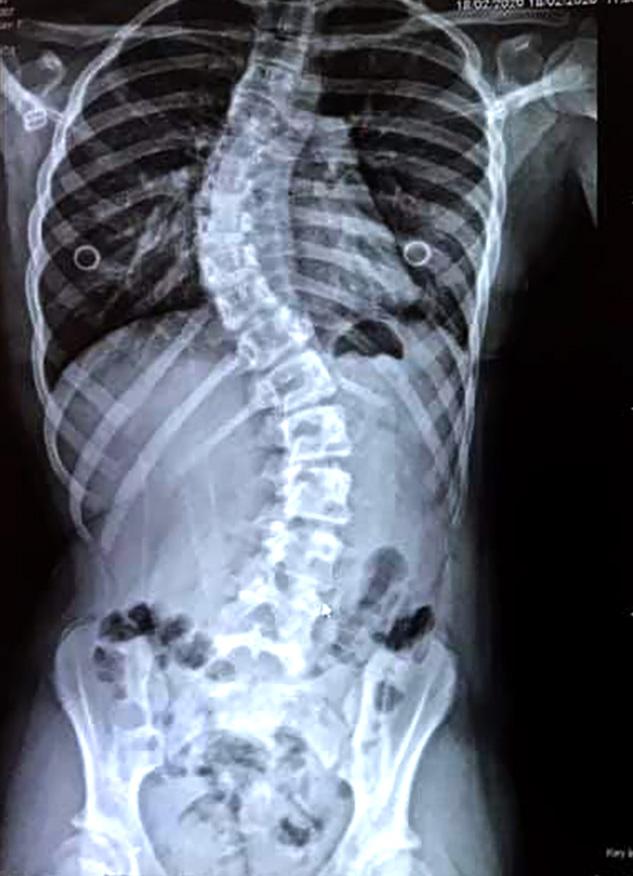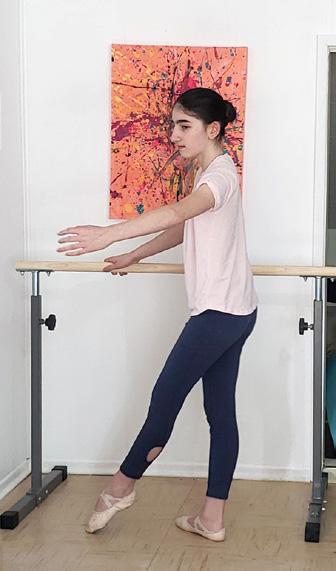
5 minute read
Set straight

Resilient: Panagiota Rounis, 14, discovered she has scoliosis a year ago. Her X-ray shows a curve of 51 degrees. Here she's recovering at BC Children's Hospital after two 8-hour days of surgery.
A new surgery helps a local teen dancer with an ancient problem: spinal scoliosis
Advertisement
By Panagiota Rounis
Iused to think that I was just a normal kid and never thought about why some activities were harder for me. I really like dance and I found some of the movements hard. My teacher would always make sure we had perfect posture. That was certainly hard for me although I didn’t really know why, until one day my ballet teacher tried to correct my stance.
This was the first sign of scoliosis. My ballet teacher, Miss Chantelle, noticed my back and shoulders were off as I seemed to lean to one side. She reached out to my parents and suggested that I go see my doctor to make sure it wasn’t anything serious. That was in September of 2019.
By October, I had an appointment with a specialist in Victoria and had xrays on my spine. The doctor then told us that I had scoliosis.
It was something I'd never heard of before. He explained it was when a curve is formed in your spine. So instead of being straight, I had a spine that looked like a backwards S. The degrees were 47° on the top curve and 45° on the bottom curve.
I had many questions such as why was my spine curved? Would I have to undergo surgery? Is there a brace or can I do some exercises to straighten my spine? Will I grow out of it?
I didn’t get all the answers I was looking for but I was told that I would be seeing someone at BC Children's Hospital and talk with the scoliosis specialist doctor there and he would explain what the treatment would be although he did say that there was a 90 percent chance I'd need surgery.
Around the middle of February, I had my first appointment. We did more Xrays and some other tests like an Xray of my hand to determine if my growth plates had closed. Since my original Xrays in October my curvatures had increased to 51° each with a rotation.
Dr. Firoz Miyanji informed me that I would definitely need surgery. I learned that there was an option to have my spine fused, which didn’t sound like a great option to me based on what I knew, but I was a really good candidate for a new type of surgery. It's called a VBT (Vertebral Body Tethering).

Conquering a flight of stairs 72-hours post-op.

Panagiota was dancing three weeks after her surgery.
We were a little unsure considering that the VBT had only been established in 2012 but Dr. Miyanji informed us that the VBT surgery was less invasive and only took three-month recovery before I could start dancing or showing dogs again. Fusion surgery is more invasive and has a nine-month recovery. We decided on the VBT.
March 3 we were back Vancouver for surgery. I’d never had surgery so it was all a bit overwhelming. The day before I had tons of pre-op tests and the next morning we were getting ready to go for surgery. I remember waking up very early and then waiting in a room with my dad I definitely wasn’t as confident as I should have been but I knew it would help me.
The first surgery was on my lower back coming from the left side and attaching tethers to pull my spine straight. The next day was the same thing but on my right upper back with the addition of deflating my lung.
Each surgery was eight hours long. The first few days after surgery are a little blurry and I was in a lot of pain and couldn’t move. But by day three we started working on my mobility. By the end of that day I was able to sit up and walk to the bathroom with help. The next day I stood up on my own and walked down the hallway.
We worked on walking for a little bit, and then the last test came it was to walk up and down a flight of stairs, if I could do that I could go home.
Recovery after that has been going well. It’s been around six months since my surgery and I'm able to do everything except use a trampoline.
I am part of a long term study on the recovery of patients that have had this surgery and I am happy my experience will help someone else. I will continue to have check ups with Dr. Miyanji and his team until I am 18.
I’m really grateful to my amazing team of Doctors at Children’s who found out why things were harder for me and have come up with a solution that has helped so many kids like me. Z
Could humanity's scoliosis nightmare finally end?
By Pieta Woolley
For thousands of years, scoliosis has hobbled people; about one in 50 women and one in 200 men. Famous historical sufferers included the Egyptian Pharaoh Tutankhamun, the Greek philosopher Hippocrates, potentially the woman Jesus met at the well, and the "hunchback" King Richard III (above right, bottom). The 2012 discovery of his grave under a Leicester parking lot allowed archaeologists to measure the severity of this royal spine's curvature: a whopping 85 degrees (the X-ray at top shows a 51 degree curve). 500 years ago, doctors made the first scoliosis braces for children - from iron. The tortuous treatments continued into the 1800s, when a plaster of Paris brace came with a contraption that suspended a patients' arms over their head. By the 1920s, exercises were pioneered to minimize discomfort and correct posture. In the 1960s, fusing surgeries began - but they immobilized the spine. You probably remember scoliosis sufferers from your own younger years who were given pioneering surgeries and treatments.
Treatment has come a long way. In our own times, you'd likely never guess that cellist Yoyo Ma (left, bottom), actress and former Miss America Vanessa Williams (top left) and even Olympic runner Usain Bolt all have scoliosis.
What Panagiota Rounis underwent - Vertebral Body Tethering - is the first scoliosis spine surgery that allows for the full range of movement of a dancer. It was first tried in humans just 10 years ago, and is still not widely performed. Scoliosis patients from throughout history - especially those who endured painful, invasive, and less-than-effective treatments - would be envious of Panagiota's recovery.

Former Miss America Vanessa Williams

Egyptian Pharaoh Tutankhamun

Cellist Yoyo Ma

The "hunchback" King Richard III


